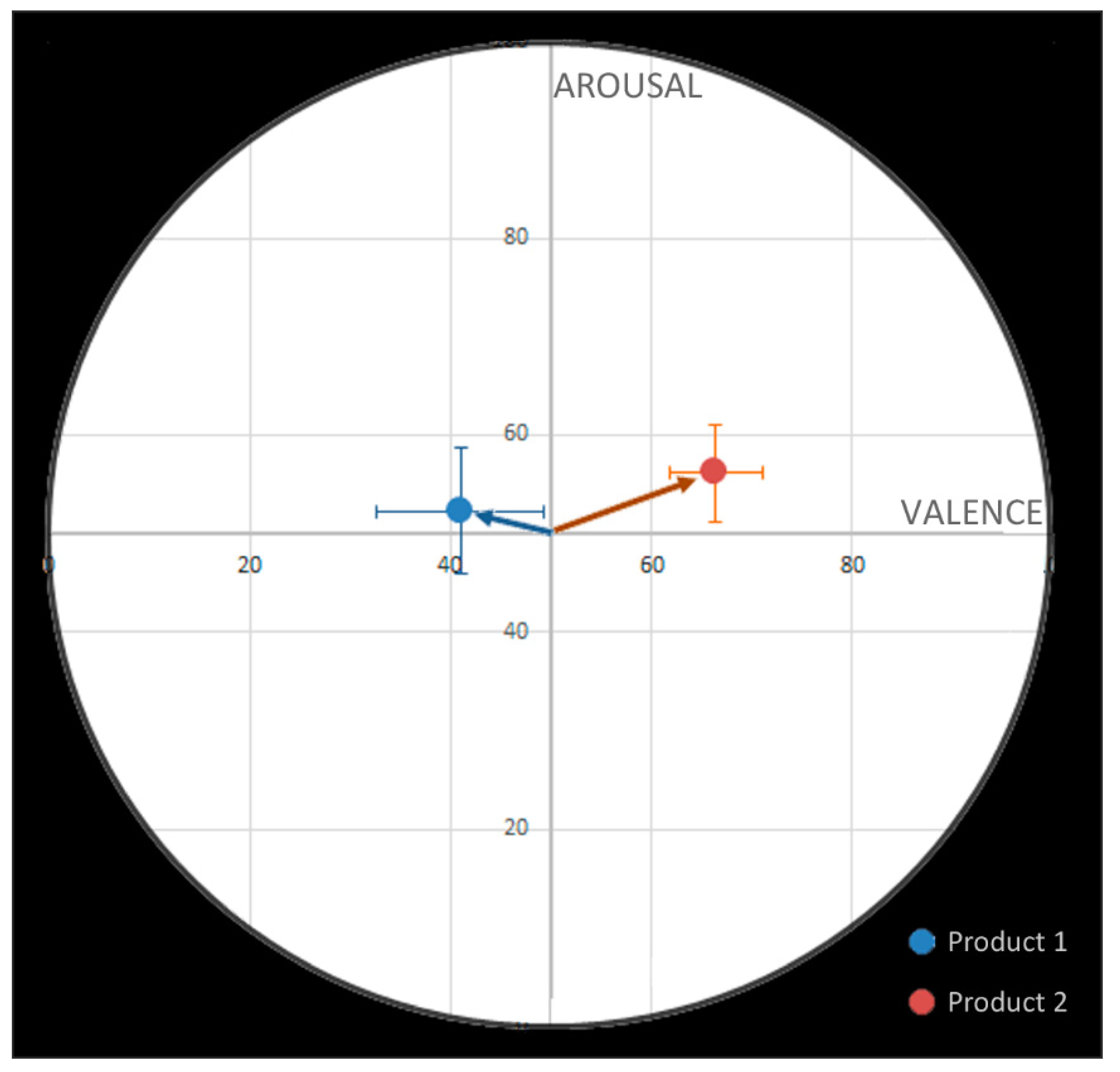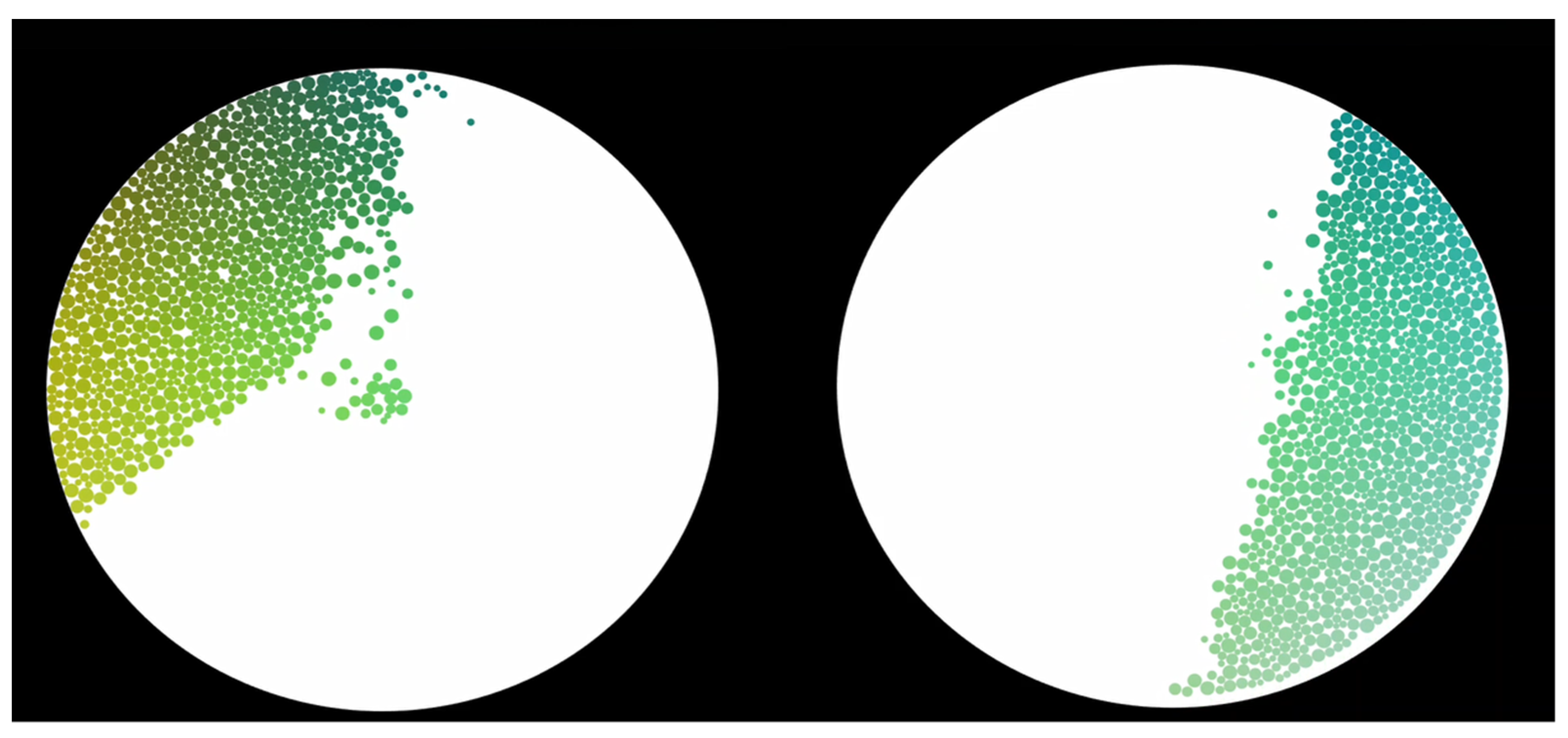Emotional Effects Induced by the Application of a Cosmetic Product: A Real-Time Electrophysiological Evaluation
Abstract
:Featured Application
Abstract
1. Introduction
2. Materials and Methods
2.1. Population
2.2. Product Description
2.3. Course of the Experiment
2.4. Brain Data Acquisition
2.5. Processing of EEG Data
2.6. Data Visualization
2.7. Data Analysis
3. Results
3.1. Behavioral Evaluation of the Two Cosmetic Products
3.2. Neural Evaluation of the Two Cosmetic Products
3.3. Real-Time Representation of the Emotions
4. Discussion
5. Conclusions
Author Contributions
Funding
Institutional Review Board Statement
Informed Consent Statement
Data Availability Statement
Acknowledgments
Conflicts of Interest
References
- Graham, J.A.; Jouhar, A.J. Cosmetics considered in the context of physical attractiveness: A review. Int. J. Cosmet. Sci. 1980, 2, 77–101. [Google Scholar] [CrossRef]
- Picot-Lemasson, A.; Decocq, G.; Aghassian, F.; Leveque, J.L. Influence of hairdressing on the psychological mood of women. Int. J. Cosmet. Sci. 2001, 23, 161–164. [Google Scholar] [CrossRef] [PubMed]
- Korichi, R.; Pelle-de-Queral, D.; Gazano, G.; Aubert, A. Why women use makeup: Implication of psychological traits in makeup functions. J. Cosmet. Sci. 2008, 59, 127–137. [Google Scholar]
- Pensé-Lhéritier, A.-M. Recent developments in the sensorial assessment of cosmetic products: A review. Int. J. Cosmet. Sci. 2015, 37, 465–473. [Google Scholar] [CrossRef]
- Barkat, S.; Thomas-Danguin, T.; Bensafi, M.; Rouby, C.; Sicard, G. Odor and color of cosmetic products: Correlations be-tween subjective judgement and autonomous nervous system response. Int. J. Cosmet. Sci. 2003, 25, 273–283. [Google Scholar] [CrossRef]
- Abriat, A.; Barkat, S.; Bensafi, M.; Rouby, C.; Fanchon, C. Psychological and physiological evaluation of emotional effects of a perfume in menopausal women. Int. J. Cosmet. Sci. 2007, 29, 399–408. [Google Scholar] [CrossRef] [PubMed]
- Lombardi, S.A.; Ratti, A. Emotional effects induced by lip balms containing different emollients: Neuroscientific ap-proach to studying the tactual experience. Househ. Pers. Care Today 2017, 12, 42–47. [Google Scholar]
- Teplan, M. Fundamentals of EEG measurment. Meas. Sci. Rev. 2002, 2, 1–11. [Google Scholar]
- Paszkiel, S. Characteristics of Question of Blind Source Separation Using Moore-Penrose Pseudoinversion for Recon-struction of EEG Signal. In Proceedings of the ICA 2017: Automation 2017, Warsaw, Poland, 15–17 March 2017; Advances in Intelligent Systems and Computing; Szewczyk, R., Zieliński, C., Kaliczyńska, M., Eds.; Springer: Cham, Switzerland, 2017; Volume 550. [Google Scholar]
- Querleux, B.; Gazano, G.; Mohen-Domenech, O.; Jacquin, J.; Burnod, Y.; Gaudion, P.; Jolivet, O.; Bittoun, J.; Benali, H. Brain activation in response to a tactile stimulation: Functional magnetic resonance imaging (FMRI) versus cognitive analysis. Int. J. Cosmet. Sci. 1999, 21, 107–118. [Google Scholar] [CrossRef]
- Paszkiel, S.; Szpulak, P. Methods of Acquisition, Archiving and Biomedical Data Analysis of Brain Functioning, Bio-Medical Engineering and Neuroscience; Book Series: Advances in Intelligent Systems and Computing; Springer: Cham, Switzerland, 2018; pp. 158–171. [Google Scholar]
- Citron, F.M.M.; Gray, M.A.; Critchley, H.D.; Weekes, B.S.; Ferstl, E.C. Emotional valence and arousal affect reading in an in-teractive way: Neuroimaging evidence for an approach-withdrawal framework. Neuropsychologia 2014, 56, 79–89. [Google Scholar] [CrossRef] [Green Version]
- Barrett, L.F.; Russell, J.A. The Structure of Current Affect: Controversies and Emerging Consensus. Curr. Dir. Psychol. Sci. 1999, 8, 10–14. [Google Scholar] [CrossRef]
- Lang, P.J.; Bradley, M.M.; Cuthbert, B.N. Motivated attention: Affect, activation, and action. In Attention and Orienting: Sensory and Motivational Processes; Mahwah, N.J., Ed.; Lawrence Erlbaum Associates Publishers: Mahwah, NJ, USA, 1997; pp. 97–135. [Google Scholar]
- Russell, J.A. Core affect and the psychological construction of emotion. Psychol. Rev. 2003, 110, 145–172. [Google Scholar] [CrossRef]
- Spielberg, J.M.; Miller, G.A.; Warren, S.L.; Engels, A.S.; Crocker, L.D.; Banich, M.T.; Sutton, B.P.; Heller, W. A brain network instantiating ap-proach and avoidance motivation. Psychophysiology 2012, 49, 1200–1214. [Google Scholar] [CrossRef] [PubMed] [Green Version]
- Davidson, R.J. EEG measures of cerebral asymmetry: Conceptual and methodological issues. Int. J. Neurosci. 1988, 39, 71–89. [Google Scholar] [CrossRef] [PubMed]
- Davidson, R.J. Anterior electrophysiological asymmetries, emotion, and depression: Conceptual and methodological conundrums. Psychophysiology 1998, 35, 607–614. [Google Scholar] [CrossRef] [PubMed]
- Papousek, I.; Weiss, E.M.; Schulter, G.; Fink, A.; Reiser, E.M.; Lackner, H.K. Prefrontal EEG alpha asymmetry changes while observing disaster happening to other people: Cardiac correlates and prediction of emotional impact. Biol. Psychol. 2014, 103, 184–194. [Google Scholar] [CrossRef]
- Wheeler, R.E.; Davidson, R.J.; Tomarken, A.J. Frontal brain asymmetry and emotional reactivity: A biological substrate of affective style. Psychophysiology 1993, 30, 82–89. [Google Scholar] [CrossRef]
- Arjmand, H.-A.; Hohagen, J.; Paton, B.; Rickard, N.S. Emotional Responses to Music: Shifts in Frontal Brain Asymmetry Mark Periods of Musical Change. Front Psychol. 2017, 8, 2044. [Google Scholar] [CrossRef] [Green Version]
- Aftanas, L.I.; Golocheikine, S.A. Human anterior and frontal midline theta and lower alpha reflect emotionally positive state and internalized attention: High-resolution EEG investigation of meditation. Neurosci. Lett. 2001, 310, 57–60. [Google Scholar] [CrossRef]
- Ertl, M.; Hildebrandt, M.; Ourina, K.; Leicht, G.; Mulert, C. Emotion regulation by cognitive reappraisal-the role of frontal theta oscillations. NeuroImage 2013, 81, 412–421. [Google Scholar] [CrossRef]
- Paquette, V.; Beauregard, M.; Beaulieu-Prévost, D. Effect of a psychoneurotherapy on brain electromagnetic tomogra-phy in individuals with major depressive disorder. Psychiatry Res. 2009, 174, 231–239. [Google Scholar] [CrossRef]
- Pizzagalli, D.A.; Nitschke, J.B.; Oakes, T.R.; Hendrick, A.M.; Horras, K.A.; Larson, C.L.; Abercrombie, H.C.; Schaefer, S.M.; Koger, J.V.; Benca, R.M. Brain electrical tomography in depression: The importance of symptom severity, anxiety, and melancholic features. Biol. Psychiatry 2002, 52, 73–85. [Google Scholar] [CrossRef]
- Ramirez, R.; Palencia-Lefler, M.; Giraldo, S.; Vamvakousis, Z. Musical neurofeedback for treating depression in elderly people. Front. Neurosci. 2015, 9, 354. [Google Scholar] [CrossRef] [PubMed] [Green Version]
- Ramirez, R.; Vamvakousis, Z. Detecting emotion from EEG signals using the emotive epoc device. In Proceedings of the 2012 International Conference on Brain Informatics, LNCS 7670, Macau, China, 4–7 December 2021; Springer: Berlin/Heidelberg, Germany, 2012; pp. 175–184. [Google Scholar]
- Gabriel, D.; Chabin, T.; Joucla, C.; Bussière, T.; Tarka, A.; Galmes, N.; Comte, A.; Bertrand, G.; Giustiniani, J.; Haffen, E. An Artistic Approach to Neurofeedback for Emotion Regulation. NeuroRegulation 2020, 7, 84–94. [Google Scholar] [CrossRef]
- Introduction of a pilot study. Korean J. Anesthesiol. 2017, 70, 601–605. [CrossRef] [PubMed] [Green Version]
- Russell, J.A. A circumplex model of affect. J. Pers. Soc. Psychol. 1980, 39, 1161–1178. [Google Scholar] [CrossRef]
- Chabin, T.; Gabriel, D.; Chansophonkul, T.; Michelant, L.; Joucla, C.; Haffen, E.; Moulin, T.; Comte, A.; Pazart, L. Cortical Patterns of Pleasurable Mu-sical Chills Revealed by High-Density EEG. Front. Neurosci. 2020, 14, 565815. [Google Scholar] [CrossRef]
- Chabin, T.; Gabriel, D.; Haffen, E.; Moulin, T.; Pazart, L. Are the new mobile wireless EEG headsets reliable for the evalu-ation of musical pleasure? PLoS ONE 2020, 15, e0244820. [Google Scholar] [CrossRef]
- Clarke, A.R.; Barry, R.J.; Karamacoska, D.; Johnstone, S.J. The EEG Theta/Beta Ratio: A marker of Arousal or Cognitive Processing Capacity? Appl. Psychophysiol. Biofeedback 2019, 44, 123–129. [Google Scholar] [CrossRef]
- Apaolaza-Ibañez, V.; Hartmann, P.; Diehl, S.; Terlutter, R. Women satisfaction with cosmetic brands: The role of dissat-isfaction and hedonic brand benefits. Afr. J. Bus. Manag. 2011, 5, 792–802. [Google Scholar]
- Aftanas, L.I.; Lotova, N.V.; Koshkarov, V.I.; Popov, S.A. Non-linear dynamical coupling between different brain areas during evoked emotions: An EEG investigation. Biol. Psychol. 1998, 48, 121–138. [Google Scholar] [CrossRef]
- Altenmüller, E.; Schürmann, K.; Lim, V.K.; Parlitz, D. Hits to the left, flops to the right: Different emotions during listen-ing to music are reflected in cortical lateralisation patterns. Neuropsychologia 2002, 40, 2242–2256. [Google Scholar] [CrossRef]
- Ramachandran, V.S.; Brang, D. Tactile-emotion synesthesia. Neurocase 2008, 14, 390–399. [Google Scholar] [CrossRef] [PubMed]
- Robinson, C.J.; Burton, H. Organization of somatosensory receptive fields in cortical areas 7b, retroinsula, postaudi-tory and granular insula of M. fascicularis. J. Comp. Neurol. 1980, 192, 69–92. [Google Scholar] [CrossRef]
- Mishkin, M. Analogous neural models for tactual and visual learning. Neuropsychologia 1979, 17, 139–151. [Google Scholar] [CrossRef]
- Gogolla, N. The insular cortex. Curr. Biol. CB 2017, 27, R580–R586. [Google Scholar] [CrossRef] [PubMed] [Green Version]
- Coan, J.A.; Allen, J.J.B. Frontal EEG asymmetry as a moderator and mediator of emotion. Biol. Psychol. 2004, 67, 7–49. [Google Scholar] [CrossRef] [PubMed]
- Davidson, R.J. Anterior cerebral asymmetry and the nature of emotion. Brain Cogn. 1992, 20, 125–151. [Google Scholar] [CrossRef]
- Harmon-Jones, E.; Gable, P.A. On the role of asymmetric frontal cortical activity in approach and withdrawal motiva-tion: An updated review of the evidence. Psychophysiology 2018, 55. [Google Scholar] [CrossRef]
- Sutton, S.K.; Davidson, R.J. Prefrontal Brain Asymmetry: A Biological Substrate of the Behavioral Approach and Inhibi-tion Systems. Psychol. Sci. 1997, 8, 204–210. [Google Scholar] [CrossRef]
- Cook, I.A.; O’Hara, R.; Uijtdehaage, S.H.; Mandelkern, M.; Leuchter, A.F. Assessing the accuracy of topographic EEG map-ping for determining local brain function. Electroencephalogr. Clin. Neurophysiol. 1998, 107, 408–414. [Google Scholar] [CrossRef]
- Davidson, R.J.; Ekman, P.; Saron, C.D.; Senulis, J.A.; Friesen, W.V. Approach-withdrawal and cerebral asymmetry: Emotion-al expression and brain physiology. I. J. Pers. Soc. Psychol. 1990, 58, 330–341. [Google Scholar] [CrossRef] [PubMed]
- Civille, G.V.; Oftedal, K.N. Sensory evaluation techniques-make “good for you” taste “good”. Physiol. Behav. 2012, 107, 598–605. [Google Scholar] [CrossRef] [PubMed]
- Krishna, A.; Elder, R.S.; Caldara, C. Feminine to smell but masculine to touch? Multisensory congruence and its effect on the aesthetic experience. J. Consum. Psychol. 2010, 20, 410–418. [Google Scholar]
- Johnson, A.J. Cognitive facilitation following intentional odor exposure. Sensors 2011, 11, 5469–5488. [Google Scholar] [CrossRef] [Green Version]




| Proposals | Cosmetic Product 1 | Cosmetic Product 2 | ||||||||
|---|---|---|---|---|---|---|---|---|---|---|
| Totally Agree | Somewhat Agree | Agree | Somewhat Disagree | Totally Disagree | Totally Agree | Somewhat Agree | Agree | Somewhat Disagree | Totally Disagree | |
| I liked the whole product | 26.7 | 20.0 | 20.0 | 26.7 | 6.7 | 26.7 | 46.7 | 13.3 | 6.7 | 6.7 |
| I liked the texture of the product | 20.0 | 33.3 | 0.0 | 33.3 | 13.3 | 40.0 | 13.3 | 20.0 | 26.7 | 0.0 |
| I like the look of the product | 20.0 | 33.3 | 33.3 | 13.3 | 0.0 | 20.0 | 33.3 | 26.7 | 13.3 | 6.7 |
| The application of the product was easy | 26.7 | 26.7 | 26.7 | 13.3 | 6.7 | 6.7 | 60.0 | 26.7 | 0.0 | 6.7 |
| My skin is soft after its application | 26.7 | 46.7 | 20.0 | 0.0 | 6.7 | 13.3 | 40.0 | 20.0 | 20.0 | 6.7 |
| The product leaves a pleasant film on the skin | 20.0 | 33.3 | 26.7 | 13.3 | 6.7 | 13.3 | 33.3 | 26.7 | 13.3 | 13.3 |
| Type of Emotion | Product 1 (%) | Product 2 (%) | Significance (p Value) |
|---|---|---|---|
| High positive emotion | 19.7 | 37.7 | 0.04 |
| Low positive emotion | 21.3 | 28.7 | 0.31 |
| High negative emotion | 32.6 | 18.5 | 0.07 |
| Low negative emotion | 26.5 | 15.2 | 0.07 |
Publisher’s Note: MDPI stays neutral with regard to jurisdictional claims in published maps and institutional affiliations. |
© 2021 by the authors. Licensee MDPI, Basel, Switzerland. This article is an open access article distributed under the terms and conditions of the Creative Commons Attribution (CC BY) license (https://creativecommons.org/licenses/by/4.0/).
Share and Cite
Gabriel, D.; Merat, E.; Jeudy, A.; Cambos, S.; Chabin, T.; Giustiniani, J.; Haffen, E. Emotional Effects Induced by the Application of a Cosmetic Product: A Real-Time Electrophysiological Evaluation. Appl. Sci. 2021, 11, 4766. https://doi.org/10.3390/app11114766
Gabriel D, Merat E, Jeudy A, Cambos S, Chabin T, Giustiniani J, Haffen E. Emotional Effects Induced by the Application of a Cosmetic Product: A Real-Time Electrophysiological Evaluation. Applied Sciences. 2021; 11(11):4766. https://doi.org/10.3390/app11114766
Chicago/Turabian StyleGabriel, Damien, Emmanuelle Merat, Adeline Jeudy, Sophie Cambos, Thibault Chabin, Julie Giustiniani, and Emmanuel Haffen. 2021. "Emotional Effects Induced by the Application of a Cosmetic Product: A Real-Time Electrophysiological Evaluation" Applied Sciences 11, no. 11: 4766. https://doi.org/10.3390/app11114766
APA StyleGabriel, D., Merat, E., Jeudy, A., Cambos, S., Chabin, T., Giustiniani, J., & Haffen, E. (2021). Emotional Effects Induced by the Application of a Cosmetic Product: A Real-Time Electrophysiological Evaluation. Applied Sciences, 11(11), 4766. https://doi.org/10.3390/app11114766






